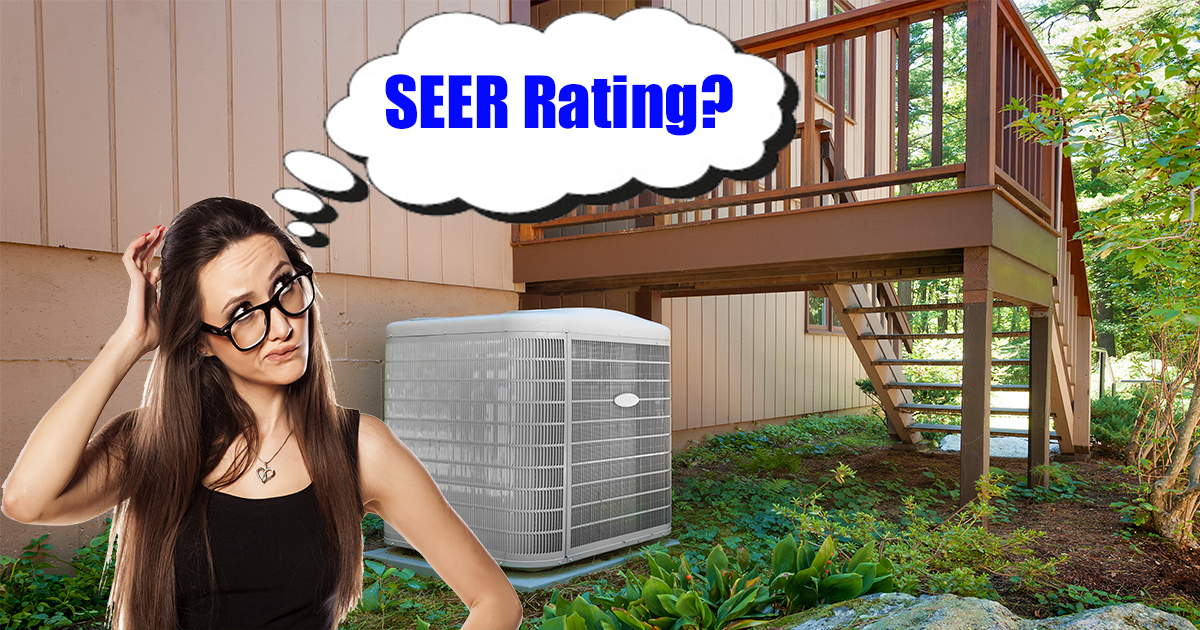The Truth About SEER (Seasonal Energy Efficiency Ratio)
Home >

So, you’re getting a new air conditioning system, and your comfort specialist has told you all about these high efficiency systems that are going to increase your comfort and drastically reduce your energy bills. Even if your air conditioner is only 10 years old, you may save 20% to 40% of your cooling energy costs by replacing it with a newer, more efficient model.
You’re excited, you’ve selected the best company and system for your home, and you’re all set to get your high-tech 16 or 18 SEER system (or higher) installed … but then you look at the yellow tag on your condenser and find that the SEER rating of the system you bought doesn’t quite reach the rating advertised.
Why is your system only going to reach, say, 15.2 SEER, when you purchased a 16 SEER system? Is your contractor trying to pull a fast one?
We get this question all the time, and there’s a very simple explanation, but first let’s quickly review what SEER means. SEER stands for Seasonal Energy Efficiency Ratio. It’s a way to measure the efficiency of an air conditioning system; it’s like the gas mileage in your car. In a nutshell, SEER tells us how much energy is used to provide a specific cooling output. Many older systems have SEER ratings of 8 or less … which means that today’s best air conditioners use 30% to 50% less energy to produce the same amount of cooling as air conditioners made in the mid-1980s.
Current SEER Standards per the Department of Energy

Now let’s talk about why your system performance might not match the SEER rating on your paperwork.
The way you drive, how often you change your oil, the air pressure in your tires, and how often your car is tuned up all affect the Miles Per Gallon you’ll get from your vehicle. Your comfort system works the same way.
Just like car manufacturers, who determine the Miles Per Gallon ratings of their vehicles under controlled testing conditions, air conditioning manufacturers also categorize their systems based on achieved SEER ratings under controlled testing conditions. Once a certain size in a model line of air conditioning equipment has been proven to reach a certain SEER rating under these testing conditions, the entire model line can now be classified as 16 SEER, or 18 SEER, or whatever rating was achieved.
This is why air conditioning manufacturers typically use the words “up to” when defining SEER ratings. They have one or two combinations and sizes of equipment in that model line that reached the optimal SEER rating under those testing conditions, while the other sizes may not achieve those top ratings.
It’s useful to note here that an Energy Star rating is a minimum efficiency rating, as opposed to a SEER rating, which is a maximum efficiency rating. This means that all systems with a certain Energy Star rating will achieve this minimum advertised output in the field.
The type of fan coil, or the furnace that your air conditioner is attached to, will also impact your system’s efficiency once installed in your home. For example, a condenser attached to a system not using an ECM blower motor will use more energy, will cost more money to operate, and will not achieve its advertised SEER rating.
With your air conditioning system, how high or low you set your thermostat, how regularly you change your air filters, and whether you have a professional technician perform annual maintenance (you do get annual maintenance, right?) will all drastically impact the efficiency of your system … and your wallet.
The air supply ductwork that is attached to your system also impacts your system’s efficiency. The air ducts in your home are like the arteries in your body. They distribute the right amount of air to the correct locations. With restricted arteries, or leaky ductwork, the health of your systems are put in jeopardy.
So, while shopping for your new AC system, bear in mind that while a high SEER rating may be the prime factor to maximizing efficiency and comfort, it’s not the only factor.
Be sure to consider your home’s insulation, and most especially its duct work, into your buying decision. After all, since average duct work leakage ranges from 25% to 40%, that means that 25 to 40 cents of every dollar you spend on cooling and heating is going out the window. Yikes!
For a more in-depth look at SEER, check out SEER: The Term Every Homeowner Should Know.
Sources:
https://inspectapedia.com/aircond/SEER_Ratings_Definitions.php
CONTACT US TODAY



As Seen & Heard On







Reach Out to Our Team for More Details
Feel free to call Sanford Temperature Control or fill out the online form for more information. You may also get in touch with our team to schedule an appointment. We look forward to hearing from you.

